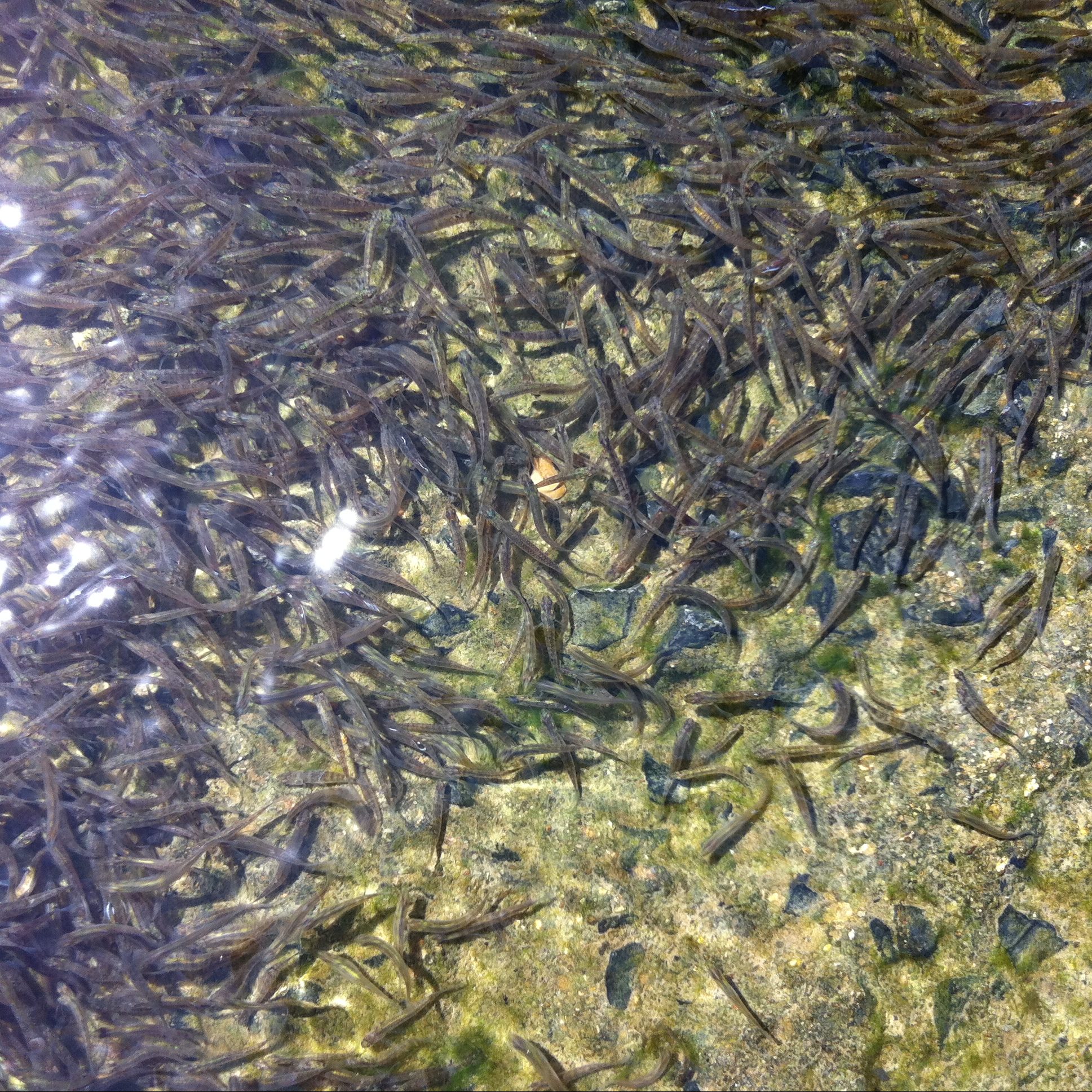Many native freshwater fish need to move between salt and freshwater areas to breed. Dams, weirs and road crossings can act as barriers to fish migration, reducing access to habitat and reducing native fish populations. Fishways are structures built to enable fish to move past these barriers. Many barriers to fish passage have been identified in the Fitzroy, and a number of organisations are working to improve fish passage.
The Fitzroy Barrage provides an important water storage for Rockhampton and the Capricorn Coast. The Barrage prevents fish such as Barramundi accessing upstream areas to feed and breed. The first fishway on the Barrage was not effective – water flows were too strong for native fish to navigate. An improved fishway was built in 1995 that provides access for over 80% of all freshwater fish recorded in the Fitzroy River. After the fishway was virtually destroyed by the 2011 flood, Fitzroy River Water rebuilt the fishway, strengthened and protected it against being damaged by future flood events
[page_divider type=”pelican”]Background[/page_divider]
Many fish need to move between salt and freshwater areas to breed. Migration also allows fish to access seasonal food sources, breeding areas, different habitat types and drought refuges. Mixing of fish stocks is also important to maintain genetic diversity.
Any structure placed across a waterway can restrict the movement of fish between different habitats, including movement between fresh and salt water. Common fish barriers are dams, weirs, roads, bridges, floodgates, causeways and culverts. Small fish are not strong swimmers, so even low barriers can block their migration. Barriers to fish passage are considered a major cause of reduced populations of fish that need to move between saltwater and freshwater environments.
Sometimes structures that are no longer needed are removed to restore fish passage. More commonly, fishways or fish ladders are constructed to allow fish to move past the barrier. There are different types of fishways, but in central Queensland most fishways are a sloping channel with a series of ridges or baffles that slow water flow. Fish move through the barrier one ridge or baffle at a time, resting in slower water after moving up each small rise.
The large, slow-moving and turbid (muddy) rivers of the Fitzroy Basin support a wide diversity of freshwater fish. Fish that are unique to the Fitzroy Basin (endemic) include the southern saratoga, Fitzroy River golden perch and leathery grunter.
Barramundi, sea mullet and mangrove jack support commercial and recreational fisheries. These three species typically move to freshwater or the upper estuary as juveniles, where they live and grow before returning to the sea to spawn as adults. To maintain healthy populations of these fish, it is important that they have access to freshwater habitats.
More than 10,000 potential barriers to fish passage have been identified in the Fitzroy – 30 of these have been identified as a high priority for fish passage. The Fitzroy Basin Association and Fisheries Queensland have built 15 fishways in recent years. One example is the creation of a ‘fish ladder’ to provide a bypass to pipes that were a barrier on Moore’s Creek in Rockhampton. The fish ladder allows many fish species, including barramundi, sea mullet, mangrove jack, tarpon, empire dudgeons, long-finned eels and pacific blue eyes to access the upstream habitat.
[page_divider type=”boats_on_fitzroy”]Case Study[/page_divider]
The Fitzroy Barrage was constructed across the Fitzroy River at Rockhampton in 1971. The Barrage is 340m wide, 3.6m high and has 18 gates that are raised or lowered to control the upstream storage level or to release water. The Fitzroy Barrage Water Supply Scheme is managed by Fitzroy River Water, and it provides the major water storage for the city of Rockhampton and nearby Gracemere, The Caves and Nerimbera. The full storage volume is 81,300ML, sufficient to supply the Rockhampton area for at least 9 months without any further inflows. The Barrage also provides irrigation water for 240 agricultural users and drinking water for the Capricorn Coast, via the Rockhampton to Yeppoon pipeline.
The Barrage separates the upstream freshwater from the tidal salt water of the Fitzroy estuary. Before the Barrage was built, the saltwater estuary extended a further 15km upstream. The estuary is now much shorter than it was before, which reduces tidal flushing, and impacts on water quality in the estuary during periods of low flow.
Juvenile barramundi used to migrate from the estuary to freshwater habitats in the lower Dawson and Mackenzie River systems. After the Barrage was built, barramundi numbers declined until they became locally extinct in these river reaches. The area immediately below the Barrage contains significant concentrations of barramundi that were not able move further upstream.
The original fishway, despite modifications, was ineffective at allowing barramundi and other fish to move past the Barrage. In 1995, the fishway was modified to a ‘vertical slot’ design on the southern bank of the river. The fishway operates when the water level is within 600mm of full supply level.
Monitoring over a two year period recorded 29 species using the fishway to access freshwater areas. Up to 3,400 fish per day were found to be using the fishway. The most common species was blue-catfish, but all fish species sampled in the estuary were found to be using the fishway. Barramundi were again able to access the Fitzroy River and tributaries. Small, immature fish are not able to successfully negotiate the fishway – the ecological significance of this is not known. Designing fishways that are effective for Australian native fish, and operate under a wide range of flow conditions is an ongoing challenge.
In the 2011 floods, the fish ladder was virtually destroyed by large rocks and flood debris. A modified design was developed by Fitzroy River Water, incorporating a stainless steel cover and stronger internal baffle plates. The $95,000 project was completed in late 2012. The structure came through the recent 2013 floods (which peaked at 8.6m in Rockhampton) with no apparent damage. The new fish ladder is expected to withstand future flood events and continue to provide a functional passage for migrating fish, with little ongoing maintenance.
[page_divider type=”ripple”]Further information[/page_divider]
Sawynok, B., 1998. Fitzroy River. Effects of freshwater flows on fish. Impact on barramundi recruitment, movement and growth. National Sportfishing Association of Qld Inc., Rockhampton.
http://publisher.onepixel.com.au/document_detail.asp?serviceid=26&documentsetid=34&documentid=331
Stuart, I.G., Mallen-Cooper, M., 1999. An assessment of the effectiveness of a vertical-slot fishway for non-salmonid fish at a tidal barrier on a large tropical/subtropical river. Regulated Rivers: Research & Management 15, 575-590.



